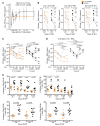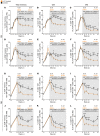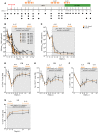Interleukin-21 combined with ART reduces inflammation and viral reservoir in SIV-infected macaques
- PMID: 26551680
- PMCID: PMC4665780
- DOI: 10.1172/JCI81400
Interleukin-21 combined with ART reduces inflammation and viral reservoir in SIV-infected macaques
Abstract
Despite successful control of viremia, many HIV-infected individuals given antiretroviral therapy (ART) exhibit residual inflammation, which is associated with non-AIDS-related morbidity and mortality and may contribute to virus persistence during ART. Here, we investigated the effects of IL-21 administration on both inflammation and virus persistence in ART-treated, SIV-infected rhesus macaques (RMs). Compared with SIV-infected animals only given ART, SIV-infected RMs given both ART and IL-21 showed improved restoration of intestinal Th17 and Th22 cells and a more effective reduction of immune activation in blood and intestinal mucosa, with the latter maintained through 8 months after ART interruption. Additionally, IL-21, in combination with ART, was associated with reduced levels of SIV RNA in plasma and decreased CD4(+) T cell levels harboring replication-competent virus during ART. At the latest experimental time points, which were up to 8 months after ART interruption, plasma viremia and cell-associated SIV DNA levels remained substantially lower than those before ART initiation in IL-21-treated animals but not in controls. Together, these data suggest that IL-21 supplementation of ART reduces residual inflammation and virus persistence in a relevant model of lentiviral disease and warrants further investigation as a potential intervention for HIV infection.
Figures







Similar articles
-
Virologic and Immunologic Features of Simian Immunodeficiency Virus Control Post-ART Interruption in Rhesus Macaques.J Virol. 2020 Jul 1;94(14):e00338-20. doi: 10.1128/JVI.00338-20. Print 2020 Jul 1. J Virol. 2020. PMID: 32350073 Free PMC article.
-
Early Antiretroviral Therapy Prevents Viral Infection of Monocytes and Inflammation in Simian Immunodeficiency Virus-Infected Rhesus Macaques.J Virol. 2020 Oct 27;94(22):e01478-20. doi: 10.1128/JVI.01478-20. Print 2020 Oct 27. J Virol. 2020. PMID: 32907978 Free PMC article.
-
Loss of Function of Intestinal IL-17 and IL-22 Producing Cells Contributes to Inflammation and Viral Persistence in SIV-Infected Rhesus Macaques.PLoS Pathog. 2016 Feb 1;12(2):e1005412. doi: 10.1371/journal.ppat.1005412. eCollection 2016 Feb. PLoS Pathog. 2016. PMID: 26829644 Free PMC article.
-
Brain Macrophages in Simian Immunodeficiency Virus-Infected, Antiretroviral-Suppressed Macaques: a Functional Latent Reservoir.mBio. 2017 Aug 15;8(4):e01186-17. doi: 10.1128/mBio.01186-17. mBio. 2017. PMID: 28811349 Free PMC article.
-
Brain macrophages harbor latent, infectious simian immunodeficiency virus.AIDS. 2019 Dec 1;33 Suppl 2(Suppl 2):S181-S188. doi: 10.1097/QAD.0000000000002269. AIDS. 2019. PMID: 31789817 Free PMC article. Review.
Cited by
-
Pharmacological Inhibition of PPARy Boosts HIV Reactivation and Th17 Effector Functions, While Preventing Progeny Virion Release and de novo Infection.Pathog Immun. 2020 Sep 30;5(1):177-239. doi: 10.20411/pai.v5i1.348. eCollection 2020. Pathog Immun. 2020. PMID: 33089034 Free PMC article.
-
Diversity of small molecule HIV-1 latency reversing agents identified in low- and high-throughput small molecule screens.Med Res Rev. 2020 May;40(3):881-908. doi: 10.1002/med.21638. Epub 2019 Oct 13. Med Res Rev. 2020. PMID: 31608481 Free PMC article. Review.
-
The loss of CCR6+ and CD161+ CD4+ T-cell homeostasis contributes to disease progression in SIV-infected rhesus macaques.Mucosal Immunol. 2017 Jul;10(4):1082-1096. doi: 10.1038/mi.2016.116. Epub 2017 Jan 4. Mucosal Immunol. 2017. PMID: 28051083 Free PMC article.
-
International AIDS Society global scientific strategy: towards an HIV cure 2016.Nat Med. 2016 Aug;22(8):839-50. doi: 10.1038/nm.4108. Epub 2016 Jul 11. Nat Med. 2016. PMID: 27400264 Free PMC article.
-
Innate Lymphoid Cells: Their Contributions to Gastrointestinal Tissue Homeostasis and HIV/SIV Disease Pathology.Curr HIV/AIDS Rep. 2019 Jun;16(3):181-190. doi: 10.1007/s11904-019-00439-4. Curr HIV/AIDS Rep. 2019. PMID: 31104270 Free PMC article. Review.
References
Publication types
MeSH terms
Substances
Grants and funding
- NCRR P51RR000165/PHS HHS/United States
- R24 OD010947/OD/NIH HHS/United States
- P51 OD011132/OD/NIH HHS/United States
- P51 RR000165/RR/NCRR NIH HHS/United States
- R33AI104278/AI/NIAID NIH HHS/United States
- ORIP/OD 5R24RR016988/OD/NIH HHS/United States
- A1001029/PHS HHS/United States
- R01AI110334/AI/NIAID NIH HHS/United States
- HHSN261200800001C/RC/CCR NIH HHS/United States
- R33 AI104278/AI/NIAID NIH HHS/United States
- R24 RR016988/RR/NCRR NIH HHS/United States
- P30 AI050409/AI/NIAID NIH HHS/United States
- R01AI116379/AI/NIAID NIH HHS/United States
- R01 AI116379/AI/NIAID NIH HHS/United States
- P30AI50409/AI/NIAID NIH HHS/United States
- P51OD011132/OD/NIH HHS/United States
- ImNIH/Intramural NIH HHS/United States
- R01 AI110334/AI/NIAID NIH HHS/United States
- HHSN261200800001E/CA/NCI NIH HHS/United States
LinkOut - more resources
Full Text Sources
Molecular Biology Databases
Research Materials

